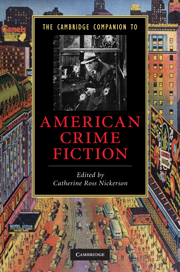Book contents
- Frontmatter
- 1 Introduction: The satisfactions of murder
- 2 Early American crime writing
- 3 Poe and the origins of detective fiction
- 4 Women writers before 1960
- 5 The hard-boiled novel
- 6 The American roman noir
- 7 Teenage detectives and teenage delinquents
- 8 American spy fiction
- 9 The police procedural in literature and on television
- 10 Mafia stories and the American gangster
- 11 True crime
- 12 Race and American crime fiction
- 13 Feminist crime fiction
- 14 Crime in postmodernist fiction
- Guide to reading
- Index
1 - Introduction: The satisfactions of murder
Published online by Cambridge University Press: 28 September 2010
- Frontmatter
- 1 Introduction: The satisfactions of murder
- 2 Early American crime writing
- 3 Poe and the origins of detective fiction
- 4 Women writers before 1960
- 5 The hard-boiled novel
- 6 The American roman noir
- 7 Teenage detectives and teenage delinquents
- 8 American spy fiction
- 9 The police procedural in literature and on television
- 10 Mafia stories and the American gangster
- 11 True crime
- 12 Race and American crime fiction
- 13 Feminist crime fiction
- 14 Crime in postmodernist fiction
- Guide to reading
- Index
Summary
When coroners and medical examiners decide that the corpse before them is the victim of homicide, they announce their findings with a ringing locution: “by a person or persons unknown.” And while the identity of the killer may truly be a cipher in the real world, within the confines of a detective novel, the perpetrator is known to us. He or she is hiding in plain sight among the array of characters in the book. What we do not know is who it is, which other characters are involved, why they did what they did, and how they pulled it off. Resolving all these questions - questions whose answers are somewhere in the text - becomes, for readers, a mental itch that we cannot scratch. We just have to know the answers. Looking for clues in a detective story is like searching for a mislaid housekey; we soon become more fixated on the fact that we cannot find it than on the necessity of the thing itself. When the author of a detective story hooks us in this way, our inflamed curiosity drives us to read with fierce attention and all due speed.
The enormous popularity of mystery and crime writing can be attributed largely to the way it structures our reading experience. There is a serious problem (a dead body, a missing child, stolen money) and there is a serious and talented person who takes up its investigation. We readers can be participants in the puzzle-solving, or we can be mere observers, but in any case we know that there will be a solution to the mystery by the end. (Certain postmodern texts play with these expectations, as Susan Elizabeth Sweeney's chapter in this volume points out.) A mystery story makes a very clear pact with its reader: “If you will endure confusion, obfuscation and false leads, I will reveal all in the end. Read me, and you will be enlightened.”
- Type
- Chapter
- Information
- Publisher: Cambridge University PressPrint publication year: 2010



